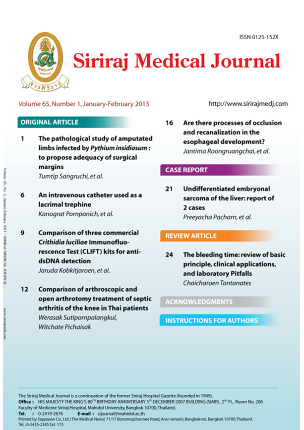The Pathological Study of Amputated Limbs Infected by Pythium insidiosum: To Propose Adequacy of Surgical Margins
Abstract
Objective: Arterial pythiosis, caused by Pythium insidiosum, is a life-threatening condition. The lesions usually involve main
arteries of the lower extremities, which extend to the abdominal aorta. Early amputation is required to save patient’s life. The
adequacy of amputation needs to ensure that the resection margins are devoid of the organisms. The aim of this study is to
suggest the level that should be devoid of organisms for surgical amputation.
Methods: We studied amputated limbs of patients diagnosed as arterial pythiosis. The major arteries of the limbs were dissected,
then serial cross cut at 0.3-0.5 cm intervals, and consecutively submitted from proximal to distal segments for routine
tissue processing and staining. Segments of non-inflamed vessels continuing above or below the level of arterial occlusion
were identified. To demonstrate fungal-like hyphae, all corresponding blocks of non-inflamed arteries were stained with
Grocott’s methenamine silver staining (GMS) and thoroughly examined under a microscope.
Results: From June 2010 to June 2011, there were 4 cases of arterial pythiosis. Chronic arteritis obliterans, acute necrotizing
arteritis with thrombosis, or a ruptured aneurysm was demonstrated from distal to proximal segments without skip lesions. At
the level of 5 cm. from the occlusion, neither arteritis nor fungal-like hyphae was identified.
Conclusion: Based on the evidence from only 4 cases, we have proposed that at 5 cm. or more above the occlusion, the noninflamed
arteries were free of P. insidiosum, while fungal hyphae might be observed in inflamed soft tissue.
Downloads
Published
How to Cite
Issue
Section
License
Authors who publish with this journal agree to the following conditions:
Copyright Transfer
In submitting a manuscript, the authors acknowledge that the work will become the copyrighted property of Siriraj Medical Journal upon publication.
License
Articles are licensed under a Creative Commons Attribution-NonCommercial-NoDerivatives 4.0 International License (CC BY-NC-ND 4.0). This license allows for the sharing of the work for non-commercial purposes with proper attribution to the authors and the journal. However, it does not permit modifications or the creation of derivative works.
Sharing and Access
Authors are encouraged to share their article on their personal or institutional websites and through other non-commercial platforms. Doing so can increase readership and citations.











